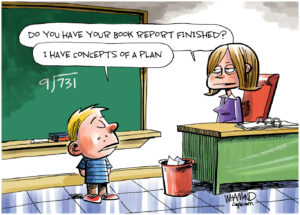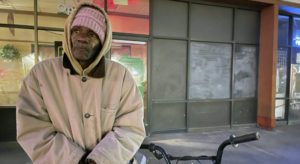The Alarming Percentage of Americans One Paycheck Away From Poverty
A new study reveals 40 percent of U.S. households are vulnerable, and their numbers are only expected to rise. An expert explains. (Blake Bolinger / Flickr)
(Blake Bolinger / Flickr)
What follows is a conversation between Prosperity Now’s Kasey Wiedrich and Greg Wilpert of The Real News Network. Read a transcript of their conversation below or watch the video at the bottom of the post.
GREG WILPERT: It’s The Real News Network and I’m Greg Wilpert, coming to you from Baltimore.
A stunning new study finds that 40 percent of U.S. families are only one paycheck away from poverty. That is, they do not have enough liquid assets to withstand a financial crisis such as the loss of a job. If they do lose their job, from one month to the next, they would be joining the ranks of the poor. This lack of assets to weather a financial crisis is even more extreme for Black and Latino households. For example, less than half of Black and Latino households have enough savings for an emergency, compared to 62.4 percent of white households.
The study was conducted by the organization Prosperity Now, and its authors are Kasey Wiedrich and David Newville. We’re now joined by one of its authors, Kasey Wiedrich. She’s the Director of Applied Research at Prosperity Now. Thanks for being here today, Kasey.
KASEY WIEDRICH: Thank you.
GREG WILPERT: So before we get into the main findings of the study, I’d like you to explain to us how your research is different from traditional poverty research, which tends to focus more on income, and why it is different.
KASEY WIEDRICH: Yeah. So at Prosperity Now, we’re working to expand economic opportunity for all Americans. And a really big focus of that is focusing on wealth and on savings. We believe that savings is the key to helping people make it through economic shocks, financial disruptions in their lives, but wealth is also the key that leads to people getting ahead. It’s really important for economic mobility, being able to plan for the future, and leaving something to the next generation.
GREG WILPERT: Now, turning to the study itself, what do you consider to be the most important findings?
KASEY WIEDRICH: Our big takeaway from 2019 is that there’s far more financial vulnerability in American households than you would believe if you only looked at the unemployment rate or statistics about the stock market or GDP. And our really key factor that we look at is savings. So the statistic that you quoted about 40 percent of households is 40 percent of households are liquid assets. So what that means is that they don’t have enough savings that if their income were interrupted, that they could replace income at the poverty level. So that doesn’t mean could they keep up with their current level consumptions, like if I lost my job, would I still have the income that I have? Do I have enough savings to replace that? It’s the most basic level of consumption. Would I have enough to get by at the poverty level?
And we see that 40 percent of households overall don’t have that basic level of security from savings. So when their incomes are interrupted, like we saw with the federal shutdown, households were having to take on debt to make ends meet, or they just weren’t paying some bills, and some had to rely on emergency assistance like food banks to get by.
GREG WILPERT: One of the things that I thought was interesting is also that you break it down by race, highlighting that there’s a really large difference between white households and Black and Latino households. Can you just say a couple of words about that? I mean, how big is that difference? How significant is it?
KASEY WIEDRICH: It’s incredibly significant. And it’s incredibly troubling, not only for those families that are going without, but it’s troubling for our economy and our country as a whole. It is that over 60 percent of Black and Latino households are liquid asset poor, versus around 30 percent of white households. And that’s just showing how vulnerable they are to any economic disruption in their lives. And that sort of lack of savings is really not because of people’s individual financial decisions and not because people aren’t choosing to save. It’s really the result of economic discrimination, institutional racism that’s been happening since our country has been founded, that has led to people being excluded from labor markets, credit markets, financial markets, sort of building up to people having less, earning less, and then being able to save less and have less wealth that they can depend upon when there are hard times.
GREG WILPERT: Another thing that I thought was interesting about the study is that it shows a trend, especially a trend between the year before last and the last year. For example, the numbers in various categories seem to have been getting worse in the past year. One example that I saw was that the number of children without health insurance had been dropping between 2010 and 2016. But then in 2017, there was a jump from 6.1 to 6.9 percent of children without health insurance. What do you attribute this jump in our wealth, income, and insurance poverty to, that took place basically since 2016?
KASEY WIEDRICH: Certainly I think the threats to the Affordable Care Act and actions on the part of the administration and Congress have impacted the measures we’re seeing in health and sort of overall in the uninsured rate. It’s been dropping since the passage of the Affordable Care Act for people overall, and this is the first year that we haven’t seen a drop. I have seen some statistics where people were saying that we didn’t see that significant of a rise is probably a success, given what’s been happening in our country and the threats to health insurance over the past year. But I think it is alarming for signs going forward if we’re seeing the loss of progress we’ve made around people’s health and their access to care.
GREG WILPERT: And at the end of your report, you have some policy recommendations. Tell us some of the ones that you think would be most important for reversing the negative trends.
KASEY WIEDRICH: Yeah. I think big picture, our priorities and policy this year are first, protecting the gains we have made and protecting the safety net that is available for people, and also keeping the consumer protections from bad actors in our economy, predatory lending, sort of high fees on different products. I think that’s sort of a baseline of protecting the hard work that advocates all across the country have done to put these protections in place for people. And I think, then, we’re also looking at different incentives to help people save and build wealth. So looking at ways for people to save for emergencies, make it easier for people to save at work that perhaps don’t have access to a retirement account through their employer, or making those accounts more easy to access if you are having emergencies so you aren’t having to take out and have a penalty if you are being charged for having to withdraw funds when there is an emergency.
And then, I think it’s also looking at ways to build wealth through homeownership, incentives for first time homebuyers, thinking about how we can make mortgage financing affordable, and then even bigger ideas about how do we give more incentives to help people get ahead. Do we look at providing wealth to children, and looking at our tax code and seeing how inequitable the incentives for building wealth are in our tax code. So it’s a big picture of trying to protect what we have now, but also, how do we provide more opportunities for more Americans to get ahead?
GREG WILPERT: It seems to me that, of course, one of the ways that you would build wealth is by saving. And one of the problems recently has been that incomes have been relatively stagnant. I think there was another interesting statistic that I saw, which I think was something between a fifth and a quarter of all jobs in the United States are basically low income–I’m not sure exactly what the term was–but are basically low income jobs, which of course in a context in which prices are going up, especially for healthcare and education, would make it almost impossible to do any savings. So to me, it seems like those would be also key areas to make sure that those rises in costs for key things that are very expensive, education and healthcare, those would have to be controlled in some way.
KASEY WIEDRICH: Absolutely. And I think the other thing to keep in mind is why, sort of looking beyond just unemployment, not all jobs are equal and not all jobs provide financial security. So the statistic we have is that it’s just over 1 in 5 jobs is in a low wage occupation nationally, and that varies really widely by states. And so, I think it is thinking through what income are people able to earn, and then what benefits do they have, whether through their employer or what benefits are provided by the state, what is the safety net at the state level? And both of those impact people’s ability to get by. Because if they’re having to spend all of their money–if the money coming in is volatile, it makes it very hard to plan. And if the expenses are really high–housing, I think, is the biggest expense that most households face month to month. And we have in our data that also it’s almost 50 percent of renters are cost-burden, meaning they’re spending more than 30 percent of their income on housing, and sort of the rule of thumb is that that is unaffordable, so it’s half of renters are paying unaffordable rents.
And if that’s the case, how do you have any money left over to save, when people are having to meet their other expenses? We’re really putting people on a rock and a hard place. And so again, I think back to that point of it’s not necessarily about the individual decisions that people are trying to make day to day, it’s about the structural things in place. And people, I think, are doing the best with the opportunities they have in front of them.
GREG WILPERT: OK. Well, we’re going to have to leave it there for now. I was speaking Kasey Wiedrich, director of applied research at Prosperity Now. Thanks again, Kasey, for having joined us today.
KASEY WIEDRICH: Thank you.
GREG WILPERT: And thank you for joining The Real News Network.
Your support matters…
Independent journalism is under threat and overshadowed by heavily funded mainstream media.
You can help level the playing field. Become a member.
Your tax-deductible contribution keeps us digging beneath the headlines to give you thought-provoking, investigative reporting and analysis that unearths what's really happening- without compromise.
Give today to support our courageous, independent journalists.








You need to be a supporter to comment.
There are currently no responses to this article.
Be the first to respond.